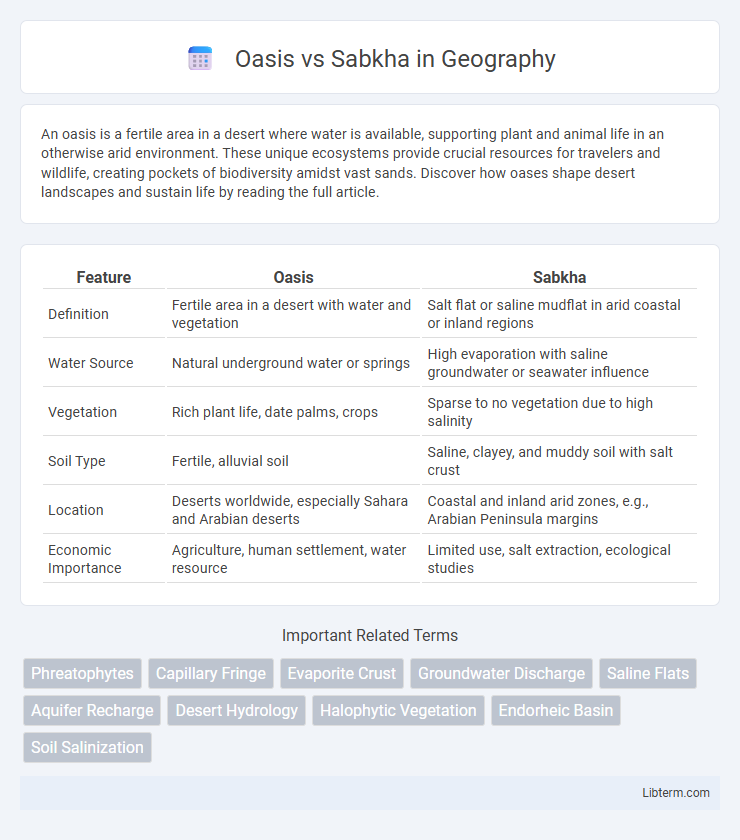An oasis is a fertile area in a desert where water is available, supporting plant and animal life in an otherwise arid environment. These unique ecosystems provide crucial resources for travelers and wildlife, creating pockets of biodiversity amidst vast sands. Discover how oases shape desert landscapes and sustain life by reading the full article.
Table of Comparison
| Feature | Oasis | Sabkha |
|---|---|---|
| Definition | Fertile area in a desert with water and vegetation | Salt flat or saline mudflat in arid coastal or inland regions |
| Water Source | Natural underground water or springs | High evaporation with saline groundwater or seawater influence |
| Vegetation | Rich plant life, date palms, crops | Sparse to no vegetation due to high salinity |
| Soil Type | Fertile, alluvial soil | Saline, clayey, and muddy soil with salt crust |
| Location | Deserts worldwide, especially Sahara and Arabian deserts | Coastal and inland arid zones, e.g., Arabian Peninsula margins |
| Economic Importance | Agriculture, human settlement, water resource | Limited use, salt extraction, ecological studies |
Introduction: Understanding Oasis and Sabkha
An oasis is a fertile area in a desert where water from underground springs or aquifers supports vegetation and human habitation, often serving as vital sources of life and agriculture. In contrast, a sabkha is a flat, salt-crusted desert landscape formed by the evaporation of groundwater, typically characterized by high salinity and sparse vegetation. Understanding the distinct hydrological and geological processes that create oases and sabkhas highlights their unique roles in arid ecosystems and resource management.
Defining Oasis: Key Characteristics
Oasis refers to a fertile area in a desert environment where water is naturally available, supporting vegetation and human settlement. Key characteristics include the presence of a groundwater source or spring, which enables the growth of palm trees, crops, and other vegetation despite surrounding arid conditions. Unlike sabkha, which is a salt flat with minimal vegetation, oases sustain diverse ecosystems and agriculture.
Defining Sabkha: Key Characteristics
Sabkha is a coastal or inland salt flat characterized by high salinity and periodic water saturation that leads to the formation of evaporite minerals such as gypsum and halite. This environment features low vegetation due to saline soil conditions and experiences fluctuating groundwater levels influenced by tidal or seasonal changes. Unlike oases, Sabkhas lack sustained fresh water sources, making them distinct ecological and geomorphological features in arid regions.
Formation Processes: Oasis vs Sabkha
Oasis formation occurs through the natural emergence of groundwater or surface water in arid regions, creating a localized area with sufficient moisture to sustain vegetation. In contrast, sabkha develops in coastal or desert settings due to the evaporation of saline groundwater, leading to the accumulation of salt crusts and evaporite minerals. While an oasis supports life by providing fresh water, sabkha is characterized by hypersaline conditions that inhibit most plant growth.
Geography and Distribution
Oases are fertile areas in arid regions where groundwater reaches the surface, supporting vegetation and human settlement, predominantly found in deserts like the Sahara and Arabian Peninsula. Sabkhas are coastal or inland salt flats characterized by high salinity and limited vegetation, typically occurring in arid and semi-arid zones such as the Persian Gulf and parts of North Africa. While oases serve as vital water sources for agriculture and habitation, sabkhas are generally inhospitable due to salt accumulation and poor drainage.
Soil and Water Conditions
Oasis soils are typically fertile with higher organic matter and better infiltration rates due to continuous water availability, supporting diverse vegetation and agriculture. Sabkha soils are saline, alkaline, and often waterlogged with poor drainage, limiting plant growth and causing salt crust formation. Water in oases is usually fresh or slightly brackish from groundwater or surface sources, while sabkha environments contain highly saline groundwater or evaporative salt flats.
Ecological Importance
Oases serve as critical ecological hotspots in arid regions by providing water sources that support diverse plant and animal life, creating microhabitats of high biodiversity. Sabkhas, salt flats found in coastal or desert areas, contribute to unique ecological functions such as salt-tolerant vegetation zones and specialized microbial communities that influence nutrient cycling. Both ecosystems play vital roles in maintaining regional ecological balance, supporting endemic species, and mitigating desertification impacts.
Human Interactions and Uses
Oases support human settlements by providing reliable sources of fresh water for drinking, agriculture, and livestock, enabling farming communities to thrive in arid deserts. Sabkhas, characterized by saline flats and limited freshwater, are less suitable for traditional agriculture but are often utilized for salt extraction and grazing salt-tolerant vegetation by local populations. Human interactions with these environments reflect adaptive strategies to water availability and soil conditions, influencing settlement patterns and resource management.
Challenges and Environmental Threats
Oases face challenges such as water scarcity, soil salinization, and over-extraction of groundwater, leading to habitat degradation and reduced agricultural productivity. Sabkhas, characterized by high salinity and extreme aridity, confront environmental threats including salt accumulation, limited vegetation cover, and vulnerability to desertification. Both ecosystems suffer from human activities like overgrazing, land conversion, and climate change impacts, which exacerbate their fragility and threaten biodiversity.
Key Differences Between Oasis and Sabkha
Oasis and sabkha are distinct ecological features primarily found in arid environments; an oasis is a fertile area with abundant freshwater supporting vegetation, whereas a sabkha is a saline flat or salt pan characterized by high soil salinity and minimal vegetation. Oases form due to groundwater surfacing or natural springs that sustain plant and animal life, while sabkhas result from evaporative processes that leave behind salt crusts, creating inhospitable conditions for most plants. Key differences include water availability, soil composition, and vegetation presence, making oases vital for human habitation and agriculture compared to the barren, salt-encrusted sabkhas.
Oasis Infographic

 libterm.com
libterm.com